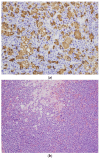The Complexities of Diagnosis with Co-Existing Gaucher Disease and Hemato-Oncology-A Case Report and Review of the Literature
- PMID: 37685585
- PMCID: PMC10488105
- DOI: 10.3390/jcm12175518
The Complexities of Diagnosis with Co-Existing Gaucher Disease and Hemato-Oncology-A Case Report and Review of the Literature
Abstract
Hematological abnormalities are the most common early symptoms of Gaucher disease (GD), with an increased risk of hematopoietic system malignancies reported in patients with GD. GD may be associated with monoclonal and polyclonal gammopathies; however, the mechanism of association of GD with multiple myeloma (MM) remains uncertain. Enzyme replacement therapy (ERT) has been shown to improve patients' cytopenia and it seems to facilitate anti-myeloma therapy in patients with co-occurring GD and MM. Although it is necessary to demonstrate the deficiency of enzymatic activity, as well as using genetic tests to finally diagnose GD, due to changes in the blood count image, bone marrow biopsy is still a frequent element of the GD diagnosis procedure. The diagnosis of GD is often delayed, mainly due to the heterogeneity of the histopathological picture of bone marrow biopsy or overlapping hematological abnormalities. Unrecognized and untreated GD worsens the response of a patient with an oncological disease to targeted treatment. We present a literature review, inspired by the case of a Caucasian patient initially diagnosed with MM and later confirmed with comorbid GD type 1 (GD1). We would like to point out the problem of underdiagnosis and delay in patients with GD.
Keywords: Gaucher disease; adult-oriented medical care; biomarkers; coordination of care; enzyme replacement therapy; genetics; molecular diagnosis; multiple myeloma.
Conflict of interest statement
The authors declare no conflict of interest.
Figures



References
-
- Grabowski G.A., Kolodny E.H., Weinreb N.J., Rosenbloom B.E., Prakash-Cheng A., Kaplan P., Charrow J., Pastores G.M., Mistry P.K. Gaucher disease: Phenotypic and genetic variation. In: Valle D.L., Antonarakis S., Ballabio A., Beaudet A.L., Mitchell G.A., editors. The Online Metabolic and Molecular Bases of Inherited Disease. The McGraw-Hill Companies Hill, Inc.; New York, NY, USA: 2019. [(accessed on 8 May 2023)]. Available online: https://ommbid.mhmedical.com/content.aspx?bookid=2709§ionid=225546386.
-
- Biegstraaten M., van Schaik I.N., Aerts J.M., Hollak C.E. ‘Non-neuronopathic’ Gaucher disease reconsidered. Prevalence of neurological manifestations in a Dutch cohort of type I Gaucher disease patients and a systematic review of the literature. J. Inherit. Metab. Dis. 2008;31:337–349. doi: 10.1007/s10545-008-0832-y. - DOI - PubMed
Publication types
LinkOut - more resources
Full Text Sources

